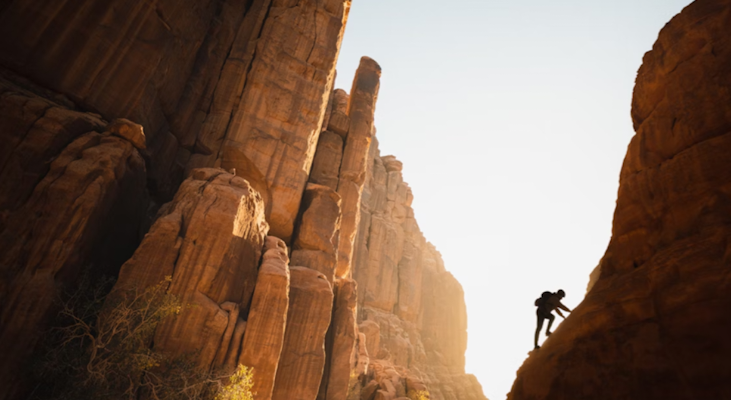Ready to up your climbing game?
There’s one key difference between a fun session and an epic day on the rock…
Your equipment.
Nearly 9 million people rock climb each year across the US, and here’s the crazy thing:
Your gear doesn’t just keep you safe…
It actually makes you a better climber.
Ok, so where to start when it comes to buying the right outdoor sports and gear? Well, a good Sun & Ski sporting goods store can be a great resource to find quality equipment that will perform when you need it most.
But here’s the issue…
Climbers tend to obsess over the wrong gear priorities. You see climbers dropping $300 on brand-name shoes while leaving the gym without ANY safety equipment. Other folks buy gear that’s more fashion statement than performance.
What you’ll discover:
- Essential Equipment That Actually Matters
- Safety Gear That Saves Lives (And Performance)
- How The Right Equipment Boosts Your Skills
- Budget-Friendly Gear That Performs
Essential Equipment That Actually Matters
So here’s a crazy thing worth pointing out to folks when they show up to the crag ready to summit Everest…
Most climbers bring way too much gear.
You don’t need more than a few essentials for most climbing you’ll do.
Let’s go over the must-haves:
Dynamic Climbing Ropes
Your rope is your lifeline. It’s also your performance multiplier.
A quality dynamic rope has two key functions:
- Absorbs the energy of falls — less shock to your body and gear
- Gives you confidence — knowing you have solid protection empowers you to climb harder
Dynamic ropes stretch when they catch a fall, reducing the force transmitted through your system. This is obviously about safety…
But when you trust your rope to protect you, you’re willing to commit to challenging moves and push your grade ceiling.
Harnesses That Fit Your Climbing Style
Harnesses are so overlooked. I mean, it’s a bag for your ass, right?
WRONG.
Not all harnesses are created equal.
Sport climbers benefit from ultra-lightweight harnesses with gear loops in the perfect position for clipping quickdraws. Trad climbers want more gear loops and more padding to support long multi-pitch days in the backcountry. Indoor climbers can get away with flimsy comfort-focused harnesses since they’re not pounding their backs on classic lines.
The right harness disappears on your body while you’re climbing. The wrong harness always screams for attention.
Climbing Shoes That Actually Work
Here’s the real scoop on climbing shoes…
Expensive doesn’t always equal better. The most expensive shoe won’t be the best for YOUR foot.
Extremely downturned shoes are made for overhanging terrain but will shred your feet on long vertical walls. Moderate shoes are workhorses for all types of climbing but lack the edge for tiny edges.
Secret? Get two pairs of shoes — one pair of precise, aggressive shoes for your project routes. And one pair of super-comfortable shoes for your volume days.
Safety Gear That Saves Lives (And Performance)
Safety gear isn’t just about avoiding an accident. It’s also about climbing with confidence.
Recent climbing safety statistics show that proper safety gear reduces the risk of death by about 70%. Safety conscious climbers live and climb to see another day.
But here’s the really interesting part…
Safety gear can also help you climb better.
Helmets: Protect Your Brain
Helmets are THE safety item most climbers choose to forgo.
And here’s why:
Helmets aren’t the sexiest accessory.
But the worst accessory? A head injury from rockfall or a failed lead fall.
Modern helmets like Petzl or Black Diamond are surprisingly comfortable. Light and well-ventilated.
Bottom line: Your brain is the most important part of your body. Protect it.
Belay Devices: Control Your Fate
Belayers hold lives in their hands. Belay devices control the rope on climbs and rappels. Get this wrong and you’re in deep trouble fast.
Tube-style belay devices are the most versatile and beginner-friendly. Assisted-braking devices add another layer of safety (and are also beginner-friendly). Figure-8 devices are the OG belay device, ideal for rappelling but not great for belaying.
Truth: Pick one device. Master it completely. Then consider adding another.
Carabiners: The Connectors That Count
All your safety gear connects with carabiners.
Both locking and non-locking carabiners are must-haves. Locking carabiners go on belay devices, anchors, personal tether. Non-locking carabiners are best for quickdraws and general connections.
Quality counts. Inferior carabiners can fail when you least expect it.
How The Right Equipment Boosts Your Skills
Ok, this is where things get fun…
The right equipment doesn’t just keep you safe. It actually makes you a better climber.
Confidence Leads to Performance
Gear you trust skyrockets your confidence. You commit to moves you might not have before. Your climbing goes to the next level.
Climbers regularly go up several grades by simply upgrading to gear they 100% trust.
Comfort Means Endurance
Comfortable gear makes you forget you’re even wearing it. No adjusting straps, no pressure points, no annoying distractions.
Fit is key. A good harness and properly-sized shoes give you hours of pain-free climbing.
Fit Improves Movement
The better your gear fits, the more your body can move efficiently and naturally.
Properly fitted shoes allow for precise footwork. Harnesses that sit right on your body don’t get in the way.
Gear that fits your body enables movement.
Budget-Friendly Gear That Performs
Don’t be fooled into thinking you need to spend big bucks to be safe on the rock.
Start with the essentials:
- Good harness ($60-120)
- Quality climbing shoes ($80-150)
- Personal belay device ($25-60)
- Locking carabiner ($15-25)
Hold off on the extras until you know your climbing style.
Used Gear: What’s Safe to Buy
Some gear is perfectly fine to buy used. Others are best new.
Safe to buy used: Harnesses (inspect for wear), climbing shoes (must have rubber left on soles), chalk bags
Buy new: Ropes, carabiners, belay devices, anything with hidden wear points
When to Upgrade Your Gear
Your climbing equipment should keep pace with your climbing ability and goals.
Upgrade when: Your current equipment is holding you back, you have a specific climbing focus you want to pursue, or safety gear shows wear.
Making Smart Equipment Decisions
The climbing gear industry is massive. Countless brands. Thousands of products. Endless marketing hype.
Stick to a few simple rules:
- Function over fashion. Gear that works > gear that’s cool.
- Buy for your style. Sport climbing = different needs than trad climbing.
- Safety = quality. Don’t cheap out on safety gear.
Wrap Up
Rock climbing gear is essential. It’s not just for your safety, but it’s also for becoming a better climber.
The right equipment provides the confidence to push your limits safely. It eliminates distractions so you can focus on movement, technique, and having fun.
But gear can’t make you safe. Climbing is a risky sport, no matter your skill or equipment. All the gear in the world can’t eliminate risk. But the right equipment can greatly reduce danger and improve your climbing experience.
Ready to hit the rock? Make sure you’re equipped to meet it head-on.











